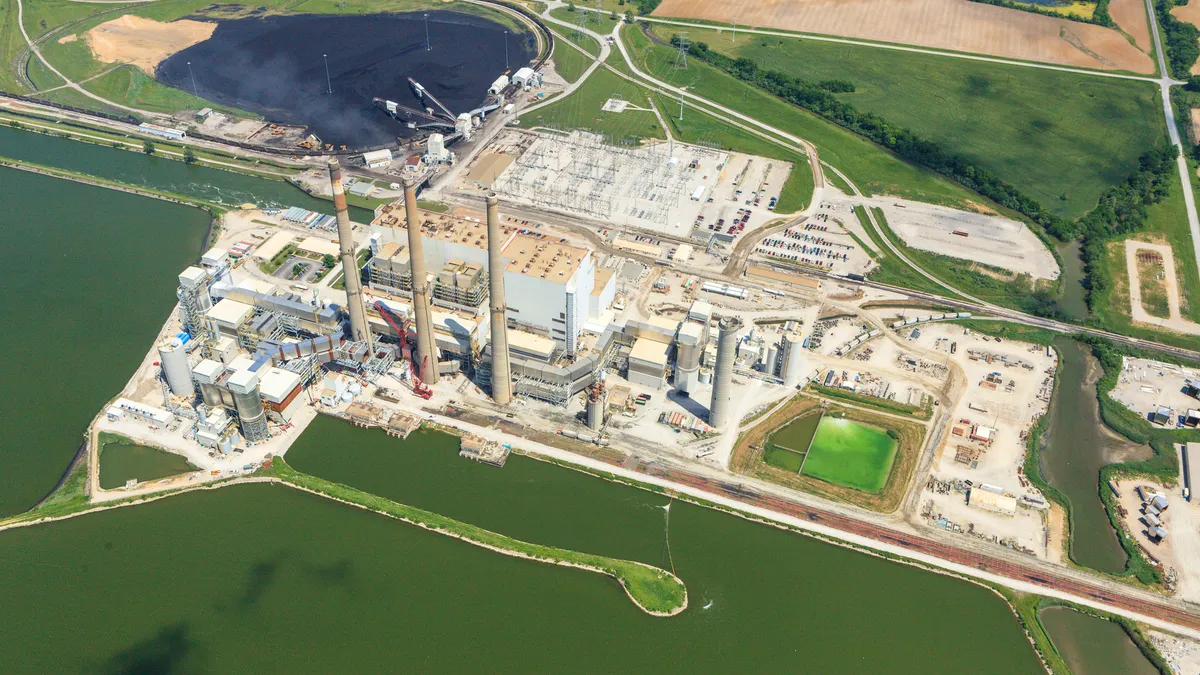Dive Brief:
-
The Federal Energy Regulatory Commission waived Vistra Corp. from Midcontinent Independent System Operator interconnection rules so the company can add battery storage at two Illinois coal-fired power plants being retired.
-
Instead of entering MISO’s interconnection queue, Vistra may use existing interconnection rights to install separate 37-MW battery storage facilities at its Joppa power station — a 948-MW coal-fired and 239-MW natural gas-fired plant — and its 560-MW coal-fired Edwards power station, according to FERC’s decision issued Tuesday. The Joppa plant was shuttered Sept. 1 and the Edwards plant is poised to close Jan. 1.
-
FERC should reconsider rules that limit a generator’s ability to transfer interconnection rights to unaffiliated entities, Commissioner Allison Clements said in a concurrence. “They are clearly hindering commercial arrangements to develop new generation at existing sites on the transmission system and may be unduly discriminating against non-incumbent generation owners,” she said.
Dive Insight:
Vistra’s waiver request centered on MISO rules governing the transfer of interconnection rights for new generating facilities at power plants without being placed in the grid operator’s interconnection queue, which would delay their deployment.
Those rules, among other things, bar an interconnection customer from selling, assigning or transferring the generating facility, the replacement generating facility or interconnection agreement from one year before the retirement of the power plant until the replacement facility starts operating, according to FERC’s decision.
Effectively, the power plant owner must also own the new facility to transfer the interconnection rights.
Vistra asked for a waiver because the planned storage projects will be owned by Vistra subsidiaries, which don’t own the power plants.
Vistra told FERC it decided to keep the ownership of the power plants and storage facilities separate partly because investors in the storage projects may be unwilling to assume liability for the coal and gas-fired generating units.
Vistra’s planned storage projects are participating in the Illinois Coal-to-Solar Energy Storage Grant Program that helps fund storage projects coming online by June 1, 2025.
If the storage projects are placed in MISO’s interconnection queue, they will be unable to begin operating by the grant program deadline, according to Vistra.
FERC’s decision comes as the agency, states and others seek ways to use existing infrastructure, such as generator interconnections, to support the energy transition. Using or upgrading facilities can be cheaper and faster than building new infrastructure.
Vistra’s request meets FERC’s criteria for receiving a waiver from MISO’s rules, according to the agency.
The request was made in good faith, solves a concrete problem, is limited in scope and won’t hurt third parties, FERC said.
“Vistra’s request does not raise queue jumping concerns because the necessary transfers do not involve unaffiliated entities outside of the interconnection queue,” FERC said.
Clements supported the decision, but called for a broad review of “nonsensical” interconnection transferability restrictions in generator replacement rules following the Vistra decision and an Indianapolis Power & Light waiver decision last year.
How can FERC restrict transfers to an unaffiliated entity if generation owners may transfer generators’ interconnection rights to affiliates that were not operating during the interconnection process, she asked.
An unaffiliated entity could see greater value in a power plant’s location on the transmission system or develop a replacement facility more cost-effectively than the current owner, Clements said.
“Why should it be restricted from acquiring the site and the interconnection rights through a transaction agreeable to buyer and seller and using the fast-track interconnection process?” Clements said. “I question whether there remains — or ever was — a basis to hinder such potentially beneficial commercial transactions that could lead to more economic re-use of sites on the transmission system.”















